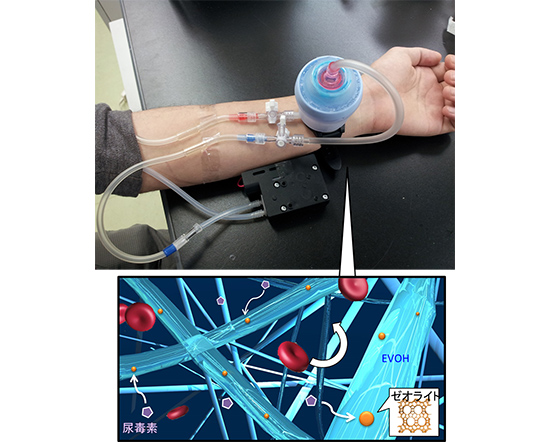Development of High-performance Fiber as an Alternative to Dialysis during Disasters
Opening a path to development of a portable dialysis system for emergency treatment of chronic kidney failure
2014.02.19
(2014.04.01 Update)
National Institute for Materials Science (NIMS)
A group of researchers led by Dr. Mitsuhiro Ebara, a MANA Scientist in the Biomaterials Unit of the International Center for Materials Nanoarchitectonics (MANA) of NIMS succeeded in developing a high-performance nanofiber mesh capable of selectively removing creatinine from among other low-molecular-weight uremic toxins in blood. This new nanofiber opens a path to development of a portable dialysis system that can be used to provide emergency treatment to patients experiencing chronic kidney failure during disasters, when essential utilities, such as electricity and water supplies, are interrupted.
Abstract
- A group of researchers led by Dr. Mitsuhiro Ebara, a MANA Scientist in the Biomaterials Unit (Unit Director: Takao Aoyagi) of the International Center for Materials Nanoarchitectonics (MANA; Director: Masakazu Aono) of NIMS (President: Sukekatsu Ushioda) succeeded in developing a high-performance nanofiber mesh capable of selectively removing creatinine from among other low-molecular-weight uremic toxins in blood. This new nanofiber opens a path to development of a portable dialysis system that can be used to provide emergency treatment to patients experiencing chronic kidney failure during disasters, when essential utilities, such as electricity and water supplies, are interrupted.
- Because conventional dialysis requires a large quantity of dialysis fluid, it becomes difficult to remove low-molecular-weight uremic toxins during emergencies when transportation systems and essential utilities such as electricity and water supplies are interrupted. In this research, the researchers succeeded in developing a nanofiber mesh capable of selectively removing a uremic toxin from blood by combining the high surface area / weight ratio of nanofiber with the uremic toxin absorption function of zeolite. More specifically, they developed a mesh-type unwoven fabric made of biocompatible polymer nanofiber containing zeolite, which can be attached to a device worn on the wrist. The zeolite used in this research has pores and properties which allow it to selectively absorb a uremic toxin. Using 25g of the new fiber, the researchers successfully removed the quantity of creatinine which normally accumulates in the human body in an hour (approx. 50mg). It will be possible to remove various kinds of uremic toxins using various kinds of nanofiber by changing the type of zeolite used.
- In Japan, more than 300,000 people suffer from chronic kidney failure and consume approximately two trillion yen in medical costs annually. Most patients manage to prolong their lives and participate in society thanks to blood purification methods such as dialysis. When essential utilities are interrupted or the treatment environment is otherwise lost, it is absolutely necessary to remove toxins, such as creatinine, and water from the bodies of patients suffering from kidney failure in order to provide emergency treatment and prevent acute uremia until the necessary infrastructure is restored. The most common blood purification method requires medical equipment supported by the appropriate infrastructure. In the wake of the Great East Japan Earthquake in 2011, patients who experienced difficulty in receiving dialysis treatment due to the interruption of utilities had no choice but to move to facilities that had escaped damage from the earthquake (in inland areas and the Tokyo metropolitan area).
- The researchers carried out their research with the goal of improving medical care during disasters. They assume that the new system they have developed may also be applicable in regions with less-developed infrastructure, including developing countries where the number of dialysis patients is increasing at an annual rate of 12%. Most patients living in these regions have no access to dialysis treatment. In addition to creatinine, the target of this research project, the researchers will continue to work to remove other uremic toxins and excess water and develop a device capable of removing all uremic toxins for use in regions with less-developed infrastructure.
- The research results was published in a science journal, Biomaterials Science, and will also be published on a website, Chemistry World, on February 19, 2014, 18:00 JST (February 18, 2014, LT).

Figure 1 A wrist-worn uremic toxin removal system that can be used during emergencies when essential utilities, such as electricity and water supplies, are interrupted. The wrist-worn device is equipped with a nanofiber mesh made of ethylene vinyl alcohol (EVOH) containing zeolite, which is capable of absorbing a uremic toxin.
